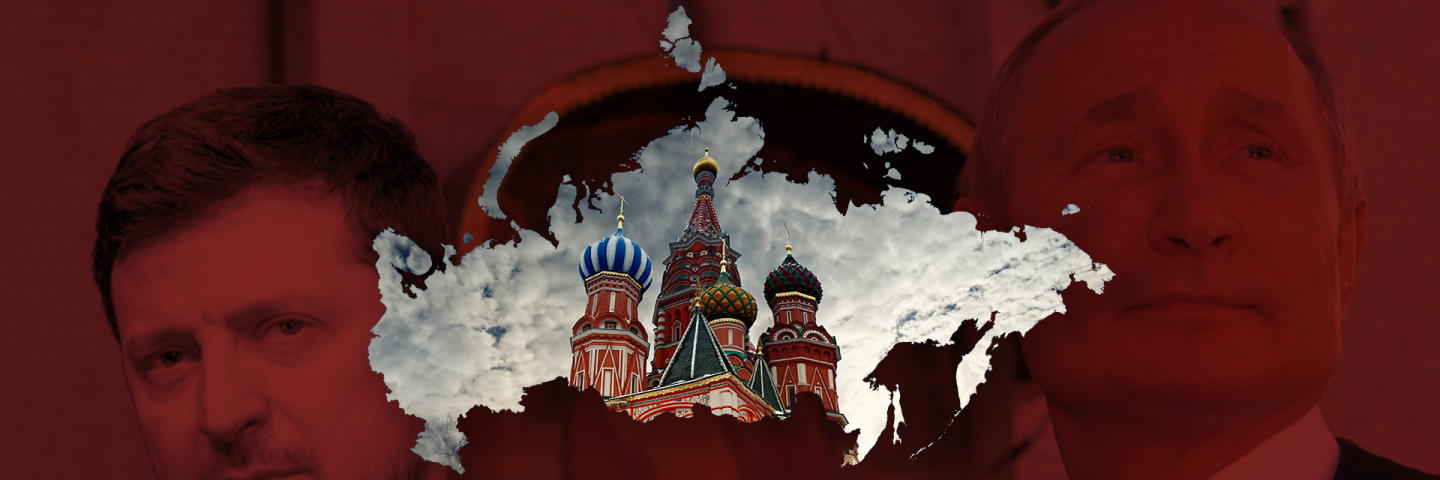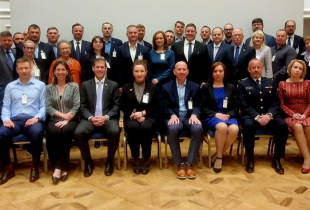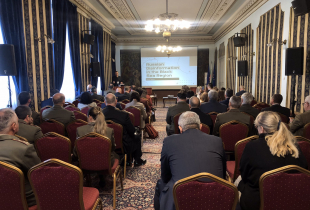
Russia End State: Stalemate in Ukraine?
Introduction
Commander-in-Chief of the Armed Forces of Ukraine, Gen. Valeriy Zaluzhnyy, published an article entitled “Modern positional warfare and how to win it.” (The Economist, November 1, 2023) Gen. Zaluzhnyy used the phrase “positional stalemate,” noting that fighting Russia has turned into positional, trench/artillery warfare due to to Russia adopting a defense in depth approach, securing lines of trenches with minefields, similar to First World War attrition-style warfare. On November 4, President Volodymyr Zelensky stated: “This situation is not a stalemate” and “We don’t have the right to give up. What’s the alternative? What, we need to give away a third of our country? That would only be the beginning. We know what a frozen conflict is, we’ve already drawn our conclusions. We need to work more with our air defense partners, unblock the skies, and give our fighters the possibility to carry out offensive operations.” (Meduza, November 4, 2023) Speculation regarding disunity among the Ukrainian strategic decision-making elite - a theme exacerbated by Russian media propaganda and fake videos designed to demoralize Ukrainian society – focused on apparent strained relationships within Ukraine’s executive authorities and the erosion of political willingness in the United States and Europe to continue to provide military and economic support to Ukraine.
This all combines to generate a pervasive sense among some western commentariat (e.g. Rachman, Financial Times, December 18, 2023) of an increased risk that Ukraine exhausts its human and materiel resources needed to defend itself against Russian aggression and then faces collapse. Over the next 1-2 years, proponents of “ceasefire now” argue that time is on Russia’s side: attritional warfare harms Ukraine more than Russia as Russia’s economy is ten times greater than Ukraine’s and its population is 4 times that of Ukraine. Given Ukraine’s comparatively limited manpower resources, the logic runs, a ceasefire/armistice on Russian terms is the best realistic outcome for Ukraine and so western partners should steer Ukraine in this direction. In this context, the $61 billion dollars requested of Congress by the Biden Administration would only slow the inevitable. Better, they argue, for Ukraine to negotiate an armistice (which may lead to a peace settlement) now when Ukraine could get better terms than wait and lose more in the future.
In this third FY24 monthly virtual seminar we place Gen. Zaluzhnyy’s article in context, explore the meaning of “positional stalemate,” and stress test its implications. Neither Russia nor Ukraine has the strategic initiative, but Russia has not yet been able to realize its advantage in manpower. Determining Russia’s balance of capabilities and forces for a long attritional war is a necessary part of the puzzle, as is the gap between what Ukraine determines that it needs to effect breakthroughs and what the West can provide at this point, as well as Ukraine’s indigenous capacity to defend itself and regenerate its forces.
Ukraine, “Modern positional warfare and how to win it”
Gen. Zaluzhnyy offered a military assessment of a high intensity and dynamic stalemate as it unfolded over 2023 and, as the article’s title suggests, it identifies what Ukraine needs to move from “positional stalemate” back to a war of maneuver: “The simple fact is that we see everything the enemy is doing and they see everything we are doing. In order for us to break this deadlock we need something new, like the gunpowder which the Chinese invented and which we are still using to kill each other.” Stalemates get broken and characterize only certain points in time. To move beyond “positional stalemate,” to breach and then breakthrough, Gen. Zaluzhnyy identified five systems to “win the war:” air superiority through aviation, advanced electronic warfare [EW], enhanced counter-battery capabilities, modern mine-breaching technologies, and building up reserves. Ultimately, Ukraine needs to develop its indigenous home-grown arms production, increase its capacity to train reserves on its territory and, almost two years into full-scale war, improve troop rotation. Gen. Zaluzhnyy’s recognition of “positional stalemate” was not a roadmap from the battlefield to the negotiating table and a ceasefire on Russian terms.
“Positional stalemate” is in fact a “dynamic stalemate” in several respects. First, although neither Russia nor Ukraine currently have the forces capable of exploiting and sustaining major offensive operations, they can both conduct offense at the local level. Second, although Gen. Zaluzhnyy’s article focuses on land warfare, arguably Russian land warfare is designed to secure Russian naval supremacy in the Black Sea. In 2014 Russia annexed Crimea, in 2018 it built the Kerch Strait bridge, and the 2022 invasion established the “land corridor” to Crimea. Ukraine has been able to degrade Russian naval capabilities, both in terms of quantity (19 ships destroyed) and symbolic strikes against the Donskoi nuclear submarine in dry dock and the HQ of the Russian Black Sea Fleet in Sevastopol. In addition, numerous Russian “red-lines” have been breached with no response, thus undermining Russia’s deterrence capability. Ukraine was able to secure a grain deal that decreased pressure on global grain prices. In addition, the balance of power in the Black Sea has shifted from Russia to Ukraine and NATO member (Bulgaria, Romania, and Türkiye) maritime forces. Third, both sides suffer from a lack of resources. The rate at which Ukraine can “metabolize” additional weapons systems, such as the F-16s and ATACMS, shapes its operational art, as does Russia’s ability to replenish its forces with domestic and imported (Iranian and North Korean) systems and ammunition. Ukraine will increase its drone warfare in Crimea over the winter, targeting Russian logistics, but while drone attacks are easier to conduct they are less impactful than missile attacks. Both Russia and Ukraine are able to intercept most drone attacks, but for infrastructure to continue to operate, especially indigenous and joint military production facilities, Ukraine needs improved air defense capabilities (see forthcoming CNA report). Fourth, in the context of a longer war, both sides face risks at the “front.” Russia, for example, compensates by escalating operations designed to limit the ability of Ukraine to fight, including cyber-attacks, assassinations, and disinformation operations designed to undermine Western support for Ukraine, as well as bringing psychological pressure to bear down on the troops.
Russia’s Balance of Capabilities and Forces for a Long War?
In order to secure Western support, it is in Ukraine’s interest to exaggerate Russian strengths as part of that request. But to what degree is the Russian Federation able to win a long-term war of attrition with Ukraine? If/when EU and U.S. aid packages to Ukraine are approved in January 2024, might this change our appreciation of Russia’s staying power? President Vladimir Putin radiates optimism but to what extent does such confidence reflect reality? We can note negative trends in Russia’s ability to sustain high intensity combat operations.
First, in terms of the production of military equipment, over the last seven months Russia’s Defense Industrial Complex (DIC) has been operating at maximum capacity. Production will start to decrease in 2024 as equipment becomes exhausted; Soviet stock will not be replenished and sanctions will degrade efforts further. Throughout 2024 the tensions and trade-offs between the labor supply needed for the DIC and attempts to expand the Russian police force and able-bodied troops for the “front line” will increase. Second, manpower shortages matter in land warfare. In 1914, Romanov Russia could in the space of several months mobilize 5 million troops from a population equivalent to today’s population. The Soviet Union achieved something similar in 1941. This number is unimaginable today due to a combination of changes in society and less developed systems for planning and carrying out military mobilization. Manpower deficits make themselves felt in terms of training cadres and battlefield troops and in this respect, Russia will likely be in a weaker position in late 2024 than it was in 2023. Russia currently “expends” more troops on the battlefield than it is able to replenish, due to the high losses the Russian Armed Forces experienced in its attempts to capture Kupyansk and Avdiivka and to prevent Ukrainian advances on Tokmak. In addition, the need to place police cordons around mosques after Friday prayers to dragoon troops suggests that Russia’s autumn draft did not go well. Volunteers are contracted for 6 months, as are prisoners, who leave service when their time is served. Those mobilized in September/October 2022 appear to have indefinite contracts or until the “Special Military Operation” (SVO) ends, a situation that is just starting to cause protests among family members of those mobilized. Desertion rates among serving soldiers and avoidance of mobilization are also factors that must be accounted for.
Russian manpower deficits are a vulnerability that could conceivably be exploited by Ukraine. Russians abroad represent a potential recruitment pool for Ukraine’s Foreign Legion to fight for “Free Russia,” particularly those that left Russia in February/March 2022 as they opposed the war, rather than the September 2022 wave leaving for Armenia, Kazakhstan, Georgia, and Türkiye to avoid mobilization. Such recruits would need a common binding ideological program (a “post-Putin Russian Parliamentary Republic?”) and identifiable political leadership in exile willing to attract such support. However, both are not readily apparent and would be difficult to attain, though numbers and fighting ability would matter less than the destructive symbolic effect they would have on mobilization within Russia.
Third, Russia’s Defense Ministry Collegium held on December 19, 2022 outlined an increase in the size of the Russian military from its current 900,000 to 1.5 million, with conscription time doubling from one to two years and 695,000 contracted soldiers. It is highly unlikely that Russia can train, restructure (from brigades to divisions), and expand its military while its field army is tied down in Ukraine. On December 14, 2023 at the “Results of the Year with Vladimir Putin,” Putin reiterated Russia’s SVO goals as “demilitarization” and “denazification” – the former goal (equated with Ukrainian attrition rates) has been a constant since February 2022, the latter has now made a comeback. Although both are broad and unquantifiable goals, which themselves suggest that Putin is reserving for himself the ability to declare “mission accomplished,” at the very least Russia will seek to take full control over the territories it has declared are formally and constitutionally Russian: certainly, Donetsk, Luhansk, and Crimea and perhaps Zaporizhzhya, Kherson, and parts of Kharkiv region. If this is so, any attempt to reformat and expand the Russian military is a mid-term prospect (8-10 years?), particularly as Ukraine is firmly set on degrading and destroying Russian forces.
Conclusions
Some western appreciation of the “glaring mismatch between ends and the available means” (Haass and Kupchan, Foreign Affairs, November 17, 2023) leads to the conclusion that a ceasefire would save lives and allow for economic reconstruction. Russia’s resources are assumed to be constant and infinite whereas Ukraine’s are not. The fact is that Russia would use a ceasefire to rearm, and that most proponents of a ceasefire do not envisage NATO trip-wire troops in Ukraine, but rather suggest that the OSCE or UN “monitors” would be sufficient. In terms of tangible issues such as manpower, a population in Ukraine of 33-34 million and in Russia of 140 million does not translate into battlefield numbers and effects. Intangibles, such as morale, training, and leadership also matter. As Ukrainian Foreign Minister Dmytro Kuleba noted: “If the war were only about numbers, we would have already lost. Russia may try to outnumber us, but the right strategy, advanced planning, and adequate support will allow us to effectively strike back.” (Foreign Affairs, December 14, 2023)
In late 2023 a misreading of the Zaluzhnyy article has generated a false dilemma: the West either keeps Ukraine in a fight that it cannot win or pushes it to forge a ceasefire with Russia. However, Ukraine can sustain its position through 2024 by focusing on defense and regeneration while allowing Russia to waste its forces through attacks that are likely to fail. At his end of year press conference on December 19, 2023, President Zelensky pledged to produce a million drones in 2024, rejected NATO membership for only part of Ukraine, and stated that Ukraine sought to mobilize an additional 450,000 to 500,000 individuals. Ukraine could then potentially return to the offensive in 2025 because it will have built up its forces, while Russia will be less strong due to the previously discussed deterioration of arms production and manpower shortages.
As Ukraine’s willingness to resist Russian aggression in its war of national survival is the golden constant, the end game in Ukraine becomes a function of the West’s understanding of the first and second order effects of Ukraine’s defeat (the West’s global survival?) and its political will to take the necessary steps to avoid it. In this respect, the EU (EUR 50 bn) and US ($61 bn) military and other aid packages for Ukraine expected in January 2024 are litmus tests of western commitment.
GCMC, Garmisch-Partenkirchen, December 19, 2023
About the Authors
Dr. Pavel K. Baev is Research Professor at the Peace Research Institute Oslo (PRIO). He is also a Senior Non-Resident Scholar at the Brookings Institution (Washington, D.C.) and a Senior Research Associate with the French International Affairs Institute (IFRI, Paris). Dr. Baev specializes in Russian military reform, Russian conflict management in the Caucasus and Central Asia, energy interests in Russia’s foreign policy, and Russian relations with Europe and NATO.
Dr. Yevgeniya Gaber is a Ukrainian foreign policy expert. She joined the GCMC’s faculty in November 2023. Prior to this, she worked as a Foreign Policy Advisor to the Prime Minister of Ukraine (2021), Deputy Director of the Diplomatic Academy at the Ministry of Foreign Affairs of Ukraine (2018-2020) and political officer in the Embassy of Ukraine in Ankara (2014-2018). Her research interests cover European and Black Sea regional security, with a focus on security and foreign policies of Ukraine, Russia, and Turkey. Dr. Gaber is widely published and has given presentations and lectures to the Estonian School of Diplomacy, Geneva Centre for Security Policy, NATO Professional Development Program, and leading universities in Europe, Canada, and the United States.
Dr. Mark Galeotti is director of the London-based consultancy Mayak Intelligence, an honorary professor at the University College London School of Slavonic and East European Studies, a senior associate fellow at the Royal United Services Institute, and a senior non-resident fellow at the Institute of International Relations Prague. He is an expert and prolific author on transnational crime and Russian security affairs. His latest books include Putin’s Wars, from Chechnya to Ukraine (London: Osprey, 2022) and The Weaponisation of Everything: A Field Guide to the New Way of War (New Haven and London: Yale University Press, 2022).
Dr. Dmitry Gorenburg is Senior Research Scientist in the Strategy, Policy, Plans, and Programs division of the Center for Naval Analysis, where he has worked since 2000. Dr. Gorenburg is an associate at the Harvard University Davis Center for Russian and Eurasian Studies and previously served as Executive Director of the American Association of the Advancement of Slavic Studies (AAASS). His research interests include security issues in the former Soviet Union, Russian military reform, Russian foreign policy, and ethnic politics and identity. He currently serves as the editor of Problems of Post-Communism.
Dr. Graeme P. Herd is a Professor of Transnational Security Studies in the Research and Policy Analysis Department at the George C. Marshall European Center for Security Studies. His latest books include Understanding Russia’s Strategic Behavior: Imperial Strategic Culture and Putin’s Operational Code (London and New York, Routledge, 2022) and Russia’s Global Reach: A Security and Statecraft Assessment, ed. Graeme P. Herd (Garmisch-Partenkirchen: George C. Marshall European Center for Security Studies, 2021).
The George C. Marshall European Center for Security Studies
The George C. Marshall European Center for Security Studies in Garmisch-Partenkirchen, Germany is a German-American partnership and trusted global network promoting common values and advancing collaborative geostrategic solutions. The Marshall Center’s mission to educate, engage, and empower security partners to collectively affect regional, transnational, and global challenges is achieved through programs designed to promote peaceful, whole of government approaches to address today’s most pressing security challenges. Since its creation in 1993, the Marshall Center’s alumni network has grown to include over 16,000 professionals from 160 countries. More information on the Marshall Center can be found online at www.marshallcenter.org.
The Clock Tower Security Series provides short summaries of Seminar Series hosted by the George C. Marshall European Center for Security Studies. These summaries capture key analytical points from the events and serve as a useful tool for policy makers, practitioners, and academics.
The articles in the The Clock Tower Security Series reflect the views of the authors (Pavel K. Baev, Yevgeniya Gaber, Mark Galeotti, Dmitry Gorenburg, and Graeme P. Herd) and are not necessarily the official policy of the United States, Germany, or any other governments.

